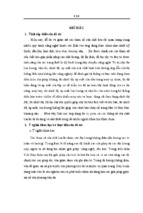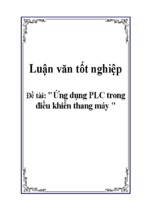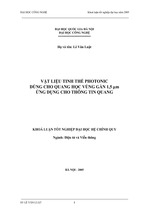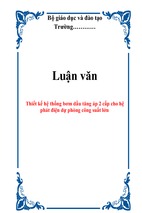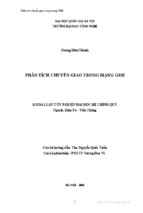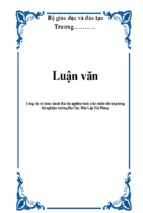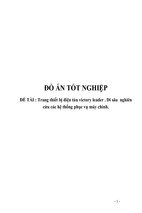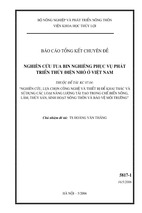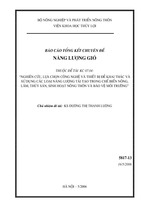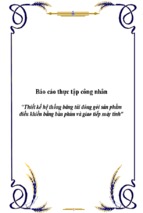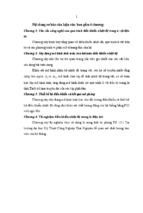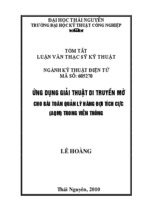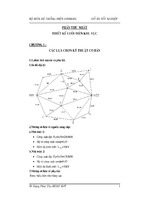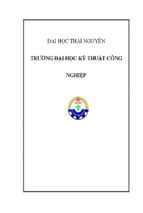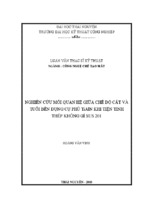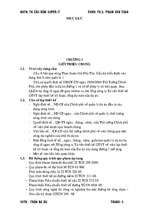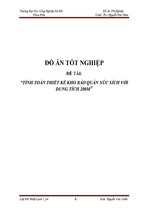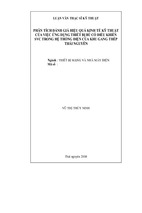A Dynamic Adaptive HTTP Streaming
Video Service for Google Android
LUCIANO RUBIO ROMERO
KTH Information and
Communication Technology
Degree project in
Communication Systems
Second level, 30.0 HEC
Stockholm, Sweden
A Dynamic Adaptive HTTP Streaming Video Service
for Google Android
Master of Science Thesis
Luciano Rubio Romero
[email protected]
Academic supervisor: Gerald Q. Maguire Jr.
Industrial supervisor: Thorsten Lohmar
School of Information and Communication Technology (ICT)
Royal Institute of Technology (KTH)
Stockholm, Sweden
October 6, 2011
To dad.
i
Abstract
Adaptive streaming approaches over Hypertext Transfer Protocol (HTTP), such as Apple’s HTTP
Live streaming (HLS) and Microsoft’s Live Smooth Streaming, have recently become very popular.
This master’s thesis project developed and evaluated several media rate adaptation algorithms
optimized for mobile networks with a client running on Google’s Android operating system.
The deployed service supports HLS and the emerging ISO/IEC MPEG standard called Dynamic
Adaptive Streaming over HTTP (MPEG-DASH).
Live media was the focus of the evaluation, since this content can not be cached in advance
at the user’s device, hence the quality of the user’s experience will be affected by the currently
available bandwidth which the user can utilize. Experiments were performed for multiple
scenarios illustrating different network capabilities, especially various amounts of bandwidth
available to the user.
This project has produced an implementation of HTTP-based adaptive streaming. This
implementation follows the MPEG standard and enables robust and smooth playback of live
video content via Google’s Android devices. Results of the experiments have shown that the
proposed adaptation mechanisms efficiently utilize the available bandwidth of the network. A
clear conclusion of this thesis is that adaptive streaming will in fact enable substantial numbers
of users to enjoy live media streaming to their devices.
Keywords: HTTP, live, video, streaming, MPEG-DASH, Android.
iii
Sammanfattning
Adaptiv strömning metoder över Hypertext Transfer Protocol (HTTP), till exempel Apples
HTTP Live streaming (HLS) och Microsoft Live Smooth Streaming, har nyligen blivit mycket
populära. Detta examensarbete utvecklas och utvärderas flera medier algoritmer anpassning
av överföringshastigheten optimerad för mobila nätverk med en klient som körs på Googles
Android-operativsystem. Systemet kommer att överväga HLS och den framväxande ISO/IEC
MPEG-standarden som kallas Dynamisk Adaptiv Strömmande över HTTP (MPEG-DASH).
Direktsendning media var i fokus för utvärderingen, eftersom detta innehåll inte kan
cachas i förväg på användarens enhet, därmed kvaliteten på användarens upplevelse
kommer att påverkas av den aktuella tillgängliga bandbredden som användaren kan utnyttja.
Experimenten utfördes för flera scenarier illustrerar olika nätverksfunktioner, särskilt olika
mängder bandbredden tillgänglig för användaren.
Detta projekt har producerat ett genomförande av HTTP-baserade adaptiva strömning. Denna
implementering följer MPEG-standarden och möjliggör robusta och smidig uppspelning av
direktsänd video innehåll via Googles Android-enheter. Resultat av experiment har visat att
den föreslagna anpassningsmekanismer effectivt sätt utnyttja den tillgängliga bandbredden i
nätverket. En tydlig slutsats i denna avhandling är att adatptive strömning faktiskt kommer att
möjliggöra ett stort antal användare att njuta direktsänd medieströmning till sina enheter.
Keywords: HTTP, live, video, strömning, MPEG-DASH, Android.
v
Acknowledgments
I am enormously grateful to Gerald Q. Maguire Jr. for his highly valuable comments and advice,
which have contributed immensely to this master’s thesis project. I would like to acknowledge
Thorsten Lohmar for giving me the opportunity to realize this project at Ericsson in Aachen,
Germany. Thorsten has provided me with thoughtful suggestions and guidance (which can be
found throughout this thesis).
I am greatly thankful to my co-workers at Ericsson for their remarkable contributions and
support: Thomas Johansson, Magued Sedra, Thorsten Dudda, Duong ’James’ Quoc Trong, Peng
Wang, Burcu Hanta, and Jairo Alfonso García Luna.
I would like to thank my friends from Toledo and my colleagues at the university, especially
Urko Serrano Badiola, Sergio Gayoso Fernández, and Sergio Floriano Sánchez from the Royal
Institute of Technology (KTH) and Federico Navarro Rodríguez and Ricardo Oña MartínezAlbelda from the Technical University of Madrid (UPM) for sharing their magnificent experience,
enthusiasm, and liveliness with me. Their friendship is gratefully acknowledged. Special thanks
goes to Reyes Albo Sánchez-Bedoya for her innumerable advice during my studies.
Finally, I would like to express my infinite gratitude to my mother and my brother for their
outstanding support in Spain and abroad. And Kathleen Streit, with love.
Contents
List of Acronyms and Abbreviations
xi
List of Tables
xiii
List of Figures
xv
List of Code Listings
xix
List of Algorithms
xxi
1
2
Introduction
1.1 The problem and motivation
1.2 Goals . . . . . . . . . . . . . . .
1.3 Scope . . . . . . . . . . . . . .
1.4 Audience . . . . . . . . . . . .
1.5 Organization of the thesis . .
.
.
.
.
.
.
.
.
.
.
.
.
.
.
.
.
.
.
.
.
.
.
.
.
.
.
.
.
.
.
.
.
.
.
.
.
.
.
.
.
1
2
4
4
4
4
Background
2.1 Traditional streaming . . . . . . . . . . . . . . . . . . . . . . . . . . . . . .
2.1.1 Real-Time Transport Protocol (RTP) . . . . . . . . . . . . . . . . .
2.1.2 Real-Time Streaming Protocol (RTSP) . . . . . . . . . . . . . . . .
2.2 Progressive download . . . . . . . . . . . . . . . . . . . . . . . . . . . . . .
2.3 Adaptive streaming . . . . . . . . . . . . . . . . . . . . . . . . . . . . . . .
2.3.1 Transcoding . . . . . . . . . . . . . . . . . . . . . . . . . . . . . . .
2.3.2 Scalable encoding . . . . . . . . . . . . . . . . . . . . . . . . . . .
2.3.3 Stream switching . . . . . . . . . . . . . . . . . . . . . . . . . . . .
2.4 HTTP-based adaptive streaming . . . . . . . . . . . . . . . . . . . . . . .
2.4.1 Why HTTP? . . . . . . . . . . . . . . . . . . . . . . . . . . . . . . .
2.4.2 Apple’s HTTP Live Streaming (HLS) . . . . . . . . . . . . . . . . .
2.4.3 Microsoft’s Live Smooth Streaming (LSS) . . . . . . . . . . . . . .
2.4.4 Adobe’s HTTP Dynamic Streaming . . . . . . . . . . . . . . . . .
2.4.5 MPEG Dynamic Adaptive Streaming over HTTP (MPEG-DASH)
2.5 Video CODECs . . . . . . . . . . . . . . . . . . . . . . . . . . . . . . . . . .
2.5.1 Video frames . . . . . . . . . . . . . . . . . . . . . . . . . . . . . .
2.5.2 Decoding and presentation time-stamps . . . . . . . . . . . . . .
2.5.3 H.263 . . . . . . . . . . . . . . . . . . . . . . . . . . . . . . . . . . .
2.5.4 H.264/MPEG-4 AVC . . . . . . . . . . . . . . . . . . . . . . . . . .
2.5.5 VP8 . . . . . . . . . . . . . . . . . . . . . . . . . . . . . . . . . . . .
2.6 Audio CODECs . . . . . . . . . . . . . . . . . . . . . . . . . . . . . . . . . .
2.6.1 MP3 . . . . . . . . . . . . . . . . . . . . . . . . . . . . . . . . . . .
2.6.2 Advanced Audio Coding (AAC) . . . . . . . . . . . . . . . . . . . .
2.6.3 Vorbis . . . . . . . . . . . . . . . . . . . . . . . . . . . . . . . . . .
2.7 Container formats . . . . . . . . . . . . . . . . . . . . . . . . . . . . . . . .
2.8 Quality video levels . . . . . . . . . . . . . . . . . . . . . . . . . . . . . . .
2.9 Video on-demand and live streaming . . . . . . . . . . . . . . . . . . . .
2.10 Google’s Android operating system . . . . . . . . . . . . . . . . . . . . . .
2.10.1 Media formats supported on Android . . . . . . . . . . . . . . . .
2.10.2 Adaptive protocols over HTTP supported on Android . . . . . .
2.10.2.1 Apple-HLS support . . . . . . . . . . . . . . . . . . . . .
.
.
.
.
.
.
.
.
.
.
.
.
.
.
.
.
.
.
.
.
.
.
.
.
.
.
.
.
.
.
.
.
.
.
.
.
.
.
.
.
.
.
.
.
.
.
.
.
.
.
.
.
.
.
.
.
.
.
.
.
.
.
.
.
.
.
.
.
.
.
.
.
.
.
.
.
.
.
.
.
.
.
.
.
.
.
.
.
.
.
.
.
.
.
.
.
.
.
.
.
.
.
.
.
.
.
.
.
.
.
.
.
.
.
.
.
.
.
.
.
.
.
.
.
.
.
.
.
.
.
.
.
.
.
.
.
.
.
.
.
.
.
.
.
.
.
.
.
.
.
.
.
.
.
.
.
.
.
.
.
.
.
.
.
.
.
.
.
.
.
.
.
.
.
.
.
.
.
.
.
.
.
.
.
.
.
.
.
.
.
.
.
.
.
.
.
.
.
.
.
.
.
.
.
.
.
.
.
.
.
.
.
.
.
.
.
.
7
7
7
8
8
8
9
9
10
11
11
12
13
14
14
16
16
17
17
17
18
18
18
18
18
19
19
20
20
21
22
22
.
.
.
.
.
.
.
.
.
.
.
.
.
.
.
.
.
.
.
.
.
.
.
.
.
.
.
.
.
.
vii
.
.
.
.
.
.
.
.
.
.
.
.
.
.
.
.
.
.
.
.
.
.
.
.
.
.
.
.
.
.
.
.
.
.
.
.
.
.
.
.
.
.
.
.
.
.
.
.
.
.
.
.
.
.
.
.
.
.
.
.
.
.
.
.
.
.
.
.
.
.
.
.
.
.
.
.
.
.
.
.
.
.
.
.
.
.
.
.
.
.
viii
CONTENTS
2.10.2.2 Microsoft-LSS support . . . . . . . . . . . . . . . . . . . . . . . . . . 22
2.10.2.3 Adobe-HDS support . . . . . . . . . . . . . . . . . . . . . . . . . . . 23
2.11 Comparison among the different HTTP-based adaptive solutions . . . . . . . . . . . 23
3
Related work
4
Design and implementation
4.1 Content preparation . . . . . . . . . . . . . . . . . . .
4.1.1 Transcoder module . . . . . . . . . . . . . . .
4.1.2 Segmenter and combiner modules . . . . . .
4.1.3 Indexing module . . . . . . . . . . . . . . . . .
4.2 Synchronization between server and client . . . . . .
4.3 HTTP Servers . . . . . . . . . . . . . . . . . . . . . . . .
4.3.1 On-demand server . . . . . . . . . . . . . . . .
4.3.2 Live server . . . . . . . . . . . . . . . . . . . . .
4.4 Client . . . . . . . . . . . . . . . . . . . . . . . . . . . .
4.4.1 Features . . . . . . . . . . . . . . . . . . . . . .
4.4.2 Adaptation mechanisms . . . . . . . . . . . .
4.4.2.1
Aggressive adaptive mechanism . .
4.4.2.2
Conservative adaptive mechanism
4.4.2.3
Mean adaptive mechanism . . . . .
4.4.3 Module characterization . . . . . . . . . . . .
4.4.3.1
Activities . . . . . . . . . . . . . . . .
4.4.4 Player module . . . . . . . . . . . . . . . . . .
4.4.4.1
Video surface management . . . . .
4.4.4.2
Implementation . . . . . . . . . . .
4.4.5 Parser module . . . . . . . . . . . . . . . . . .
4.4.5.1
DOM and SAX . . . . . . . . . . . . .
4.4.5.2
Implementation . . . . . . . . . . .
4.4.6 Segment-downloader module . . . . . . . . .
4.4.6.1
Implementation . . . . . . . . . . .
4.4.7 Rate adaptation module . . . . . . . . . . . . .
4.4.7.1
Implementation . . . . . . . . . . .
4.4.8 Transcoder module . . . . . . . . . . . . . . .
4.4.8.1
Implementation . . . . . . . . . . .
4.4.9 Timer module . . . . . . . . . . . . . . . . . . .
4.4.9.1
Implementation . . . . . . . . . . .
4.5 Network emulator . . . . . . . . . . . . . . . . . . . . .
4.5.1 Emulator requisites . . . . . . . . . . . . . . .
4.5.2 Dummynet . . . . . . . . . . . . . . . . . . . .
.
.
.
.
.
.
.
.
.
.
.
.
.
.
.
.
.
.
.
.
.
.
.
.
.
.
.
.
.
.
.
.
.
.
.
.
.
.
.
.
.
.
.
.
.
.
.
.
.
.
.
.
.
.
.
.
.
.
.
.
.
.
.
.
.
.
.
.
.
.
.
.
.
.
.
.
.
.
.
.
.
.
.
.
.
.
.
.
.
.
.
.
.
.
.
.
.
.
.
.
.
.
.
.
.
.
.
.
.
.
.
.
.
.
.
.
.
.
.
.
.
.
.
.
.
.
.
.
.
.
.
.
.
.
.
.
.
.
.
.
.
.
.
.
.
.
.
.
.
.
.
.
.
.
.
.
.
.
.
.
.
.
.
.
.
.
.
.
.
.
.
.
.
.
.
.
.
.
.
.
.
.
.
.
.
.
.
.
.
.
.
.
.
.
.
.
.
.
.
.
.
.
.
.
.
.
.
.
.
.
.
.
.
.
.
.
.
.
.
.
.
.
.
.
.
.
.
.
.
.
.
.
.
.
.
.
.
.
.
.
.
.
.
.
.
.
.
.
.
.
.
.
.
.
.
.
.
.
.
.
.
.
.
.
.
.
.
.
.
.
.
.
.
.
.
.
.
.
.
.
.
.
.
.
.
.
.
.
.
.
.
.
.
.
.
.
.
.
.
.
.
.
.
.
.
.
.
.
.
.
.
.
.
.
.
.
.
.
.
.
.
.
.
.
.
.
.
.
.
.
.
.
.
.
.
.
.
.
.
.
.
.
.
.
.
.
.
.
.
.
.
.
.
.
.
.
.
.
.
.
.
.
.
.
.
.
.
.
.
.
.
.
.
.
.
.
.
.
.
.
.
.
.
.
.
.
.
.
.
.
.
.
.
.
.
.
.
.
.
.
.
.
.
.
.
.
.
.
.
.
.
.
.
.
.
.
.
.
.
.
.
.
.
.
.
.
.
.
.
.
.
.
.
.
.
.
.
.
.
.
.
.
.
.
.
.
.
.
.
.
.
.
.
.
.
.
.
.
.
.
.
.
.
.
.
.
.
.
.
.
.
.
.
.
.
.
.
.
.
.
.
.
.
.
.
.
.
.
.
.
.
.
.
.
.
.
.
.
.
.
.
.
.
.
.
.
.
.
.
.
.
.
.
.
.
.
.
.
.
.
.
.
.
.
.
.
.
.
.
.
.
.
.
.
.
.
.
.
.
.
.
.
.
.
.
.
.
.
.
.
.
.
.
.
.
.
.
.
.
.
.
.
.
.
.
.
.
.
.
.
.
.
.
.
.
.
.
.
.
.
.
.
.
.
.
.
.
.
.
.
.
.
.
.
27
27
28
28
29
29
31
31
31
32
33
33
34
34
35
36
37
38
39
41
43
44
44
48
49
51
51
52
53
56
56
57
57
58
Evaluation
5.1 Experimental environment . . . . . . . . .
5.1.1 Experimental devices . . . . . . . .
5.1.2 Content source . . . . . . . . . . . .
5.1.3 Segmentation schemas . . . . . . .
5.1.4 Selection of media quality levels . .
5.1.5 Input and output characterization .
5.1.6 Metrics . . . . . . . . . . . . . . . . .
5.1.6.1
Weighted functions . . .
5.1.6.2
Bandwidth utilization . .
5.1.6.3
Bandwidth efficiency . .
5.1.6.4
Buffering efficiency . . .
5.1.6.5
Segment-fetch efficiency
5.1.6.6
Segment-retry efficiency
5.1.6.7
End-to-end latency . . .
.
.
.
.
.
.
.
.
.
.
.
.
.
.
.
.
.
.
.
.
.
.
.
.
.
.
.
.
.
.
.
.
.
.
.
.
.
.
.
.
.
.
.
.
.
.
.
.
.
.
.
.
.
.
.
.
.
.
.
.
.
.
.
.
.
.
.
.
.
.
.
.
.
.
.
.
.
.
.
.
.
.
.
.
.
.
.
.
.
.
.
.
.
.
.
.
.
.
.
.
.
.
.
.
.
.
.
.
.
.
.
.
.
.
.
.
.
.
.
.
.
.
.
.
.
.
.
.
.
.
.
.
.
.
.
.
.
.
.
.
.
.
.
.
.
.
.
.
.
.
.
.
.
.
.
.
.
.
.
.
.
.
.
.
.
.
.
.
.
.
.
.
.
.
.
.
.
.
.
.
.
.
.
.
.
.
.
.
.
.
.
.
.
.
.
.
.
.
.
.
.
.
.
.
.
.
.
.
.
.
.
.
.
.
.
.
.
.
.
.
.
.
.
.
.
.
.
.
.
.
.
.
.
.
.
.
.
.
.
.
.
.
.
.
.
.
.
.
.
.
.
.
61
61
62
62
62
62
64
66
66
67
67
68
68
68
69
5
25
.
.
.
.
.
.
.
.
.
.
.
.
.
.
.
.
.
.
.
.
.
.
.
.
.
.
.
.
.
.
.
.
.
.
.
.
.
.
.
.
.
.
.
.
.
.
.
.
.
.
.
.
.
.
.
.
.
.
.
.
.
.
.
.
.
.
.
.
.
.
.
.
.
.
.
.
.
.
.
.
.
.
.
.
CONTENTS
5.2
5.3
5.4
5.5
5.6
5.7
6
ix
5.1.6.8
Active efficiency . . . . . . . . . . . . . . . .
5.1.6.9
Start-up efficiency . . . . . . . . . . . . . . .
5.1.6.10 Reaction efficiency . . . . . . . . . . . . . . .
5.1.7 Network scenarios . . . . . . . . . . . . . . . . . . . . .
Scenario 1: long-term variations of the available bandwidth .
5.2.1 Performance of the adaptation mechanisms . . . . . .
5.2.1.1
Impact on the metrics . . . . . . . . . . . . .
5.2.2 Performance with different duration segments . . . .
5.2.2.1
Impact on the metrics . . . . . . . . . . . . .
5.2.3 Analysis of the end-to-end latency . . . . . . . . . . . .
5.2.4 Discussion . . . . . . . . . . . . . . . . . . . . . . . . . .
Scenario 2: short-term variations of the available bandwidth
5.3.1 Performance of the adaptation mechanisms . . . . . .
5.3.1.1
Impact on the metrics . . . . . . . . . . . . .
5.3.2 Performance with different duration segments . . . .
5.3.2.1
Impact on the metrics . . . . . . . . . . . . .
5.3.3 Analysis of the end-to-end latency . . . . . . . . . . . .
5.3.4 Discussion . . . . . . . . . . . . . . . . . . . . . . . . . .
Scenario 3: peaks in the available bandwidth . . . . . . . . . .
5.4.1 Performance of the adaptation mechanisms . . . . . .
5.4.1.1
Impact on the metrics . . . . . . . . . . . . .
5.4.2 Performance with different duration of segments . . .
5.4.2.1
Impact on the metrics . . . . . . . . . . . . .
5.4.3 Analysis of the end-to-end latency . . . . . . . . . . . .
5.4.4 Discussion . . . . . . . . . . . . . . . . . . . . . . . . . .
Scenario 4: troughs in the available bandwidth . . . . . . . . .
5.5.1 Performance of the adaptation mechanisms . . . . . .
5.5.1.1
Impact on the metrics . . . . . . . . . . . . .
5.5.2 Performance with different duration segments . . . .
5.5.2.1
Impact on the metrics . . . . . . . . . . . . .
5.5.3 Analysis of the end-to-end latency . . . . . . . . . . . .
5.5.4 Discussion . . . . . . . . . . . . . . . . . . . . . . . . . .
Effects of packet loss . . . . . . . . . . . . . . . . . . . . . . . .
5.6.1 Impact on the metrics . . . . . . . . . . . . . . . . . . .
5.6.2 Discussion . . . . . . . . . . . . . . . . . . . . . . . . . .
Evaluation with real live events . . . . . . . . . . . . . . . . . .
5.7.1 Impact on the metrics . . . . . . . . . . . . . . . . . . .
5.7.2 Discussion . . . . . . . . . . . . . . . . . . . . . . . . . .
.
.
.
.
.
.
.
.
.
.
.
.
.
.
.
.
.
.
.
.
.
.
.
.
.
.
.
.
.
.
.
.
.
.
.
.
.
.
.
.
.
.
.
.
.
.
.
.
.
.
.
.
.
.
.
.
.
.
.
.
.
.
.
.
.
.
.
.
.
.
.
.
.
.
.
.
.
.
.
.
.
.
.
.
.
.
.
.
.
.
.
.
.
.
.
.
.
.
.
.
.
.
.
.
.
.
.
.
.
.
.
.
.
.
.
.
.
.
.
.
.
.
.
.
.
.
.
.
.
.
.
.
.
.
.
.
.
.
.
.
.
.
.
.
.
.
.
.
.
.
.
.
.
.
.
.
.
.
.
.
.
.
.
.
.
.
.
.
.
.
.
.
.
.
.
.
.
.
.
.
.
.
.
.
.
.
.
.
.
.
.
.
.
.
.
.
.
.
.
.
.
.
.
.
.
.
.
.
.
.
.
.
.
.
.
.
.
.
.
.
.
.
.
.
.
.
.
.
.
.
.
.
.
.
.
.
.
.
.
.
.
.
.
.
.
.
.
.
.
.
.
.
.
.
.
.
.
.
.
.
.
.
.
.
.
.
.
.
.
.
.
.
.
.
.
.
.
.
.
.
.
.
.
.
.
.
.
.
.
.
.
.
.
.
.
.
.
.
.
.
.
.
.
.
.
.
.
.
.
.
.
.
.
.
.
.
.
.
.
.
.
.
.
.
.
.
.
.
.
.
.
.
.
.
.
.
.
.
.
.
.
.
.
.
.
.
.
.
.
.
.
.
.
.
.
.
.
.
.
.
.
.
.
.
.
.
.
.
.
.
.
.
.
.
.
.
.
.
.
.
.
.
.
.
.
.
.
.
.
.
.
.
.
.
.
.
.
.
.
.
.
.
.
.
.
.
.
.
.
.
.
.
.
.
.
.
.
.
.
.
.
.
.
.
.
.
.
.
.
.
.
.
.
.
.
.
.
.
.
.
.
.
.
.
.
.
.
.
.
.
.
.
.
.
.
.
.
.
.
.
.
.
.
.
.
.
.
.
.
.
.
.
.
.
.
.
.
.
.
.
.
.
.
.
.
.
.
.
.
.
.
.
.
.
69
69
69
70
71
71
72
73
74
75
76
76
77
78
79
80
81
81
82
82
83
84
85
86
86
87
87
88
89
90
91
91
92
92
93
93
94
95
Conclusions
97
6.1 Discussion . . . . . . . . . . . . . . . . . . . . . . . . . . . . . . . . . . . . . . . . . . . 97
6.2 Future work . . . . . . . . . . . . . . . . . . . . . . . . . . . . . . . . . . . . . . . . . . . 98
Bibliography
A Demonstration of the client’s application
A.1 Graph generator . . . . . . . . . . . . . . . . . .
A.2 Logging system . . . . . . . . . . . . . . . . . . .
A.3 Overview of the client’s GUI . . . . . . . . . . .
A.3.1 Adding media sources . . . . . . . . . .
A.3.2 Importing multiple media sources . . .
A.3.3 Searching for media sources . . . . . .
A.3.4 Modifying and deleting media sources
A.3.5 Opening a media source . . . . . . . . .
A.3.6 Playback during the streaming session
B FFmpeg capabilities
101
.
.
.
.
.
.
.
.
.
.
.
.
.
.
.
.
.
.
.
.
.
.
.
.
.
.
.
.
.
.
.
.
.
.
.
.
.
.
.
.
.
.
.
.
.
.
.
.
.
.
.
.
.
.
.
.
.
.
.
.
.
.
.
.
.
.
.
.
.
.
.
.
.
.
.
.
.
.
.
.
.
.
.
.
.
.
.
.
.
.
.
.
.
.
.
.
.
.
.
.
.
.
.
.
.
.
.
.
.
.
.
.
.
.
.
.
.
.
.
.
.
.
.
.
.
.
.
.
.
.
.
.
.
.
.
.
.
.
.
.
.
.
.
.
.
.
.
.
.
.
.
.
.
.
.
.
.
.
.
.
.
.
.
.
.
.
.
.
.
.
.
.
.
.
.
.
.
.
.
.
.
.
.
.
.
.
.
.
.
.
.
.
.
.
.
.
.
.
107
107
107
108
108
108
109
109
110
110
115
x
CONTENTS
C Integration of FFmpeg libraries using the Android NDK
117
Trivia
119
List of Acronyms and Abbreviations
3GPP
3rd Generation Partnership Project
AAC
Advanced Audio Coding
AVC
Advanced Video Coding
BP
Baseline Profile
CBP
Constrained Baseline Profile
CDN
Content Delivery Network
CODEC
COmpressor-DECompressor
CPU
Central Processing Unit
DF
Delivery Format
DOM
Document Object Model
DSS
Darwin Streaming Server
DTS
Decoding Time-Stamp
DVM
Dalvik Virtual Machine
GOP
Group Of Pictures
GUI
Graphical User Interface
HDS
Adobe’s HTTP Dynamic Streaming
HLS
Apple’s HTTP Live Streaming
HTML
Hypertext Markup Language
HTTP
HyperText Transfer Protocol
IEC
International Electrotechnical Commission
IETF
Internet Engineering Task Force
IPTV
Internet Protocol Television
ISO
International Organization for Standardization
ITU
International Telecommunication Union
JNI
Java Native Interface
JVM
Java Virtual Machine
LGPL
Lesser General Public License
LSS
Microsoft’s Live Smooth Streaming
MEGACO
Media Gateway Control Protocol
MF
Manifest File
MIME
Multipurpose Internet Mail Extensions
MMUSIC
Multiparty Multimedia Session Control (Working Group)
MS IIS
Microsoft Internet Information Services
xi
MPD
Media Presentation Description
MPEG
Moving Picture Experts Group
MPEG-DASH
MPEG Dynamic Adaptive Streaming over HTTP
M2TS
MPEG-2 Transport Stream
MVC
Multiview Video Coding
NAT
Network Address Translation
NTP
Network Time Protocol
OHA
Open Headset Alliance
OS
Operating System
PCM
Pulse-Code Modulation
PIFF
Protected Interoperable File Format
PTS
Presentation Time-Stamp
QSS
QuickTime Streaming Server
RAP
Random Access Point
RTMP
Real Time Messaging Protocol
RTP
Real-time Transport Protocol
RTCP
RTP Control Protocol
RTSP
Real Time Streaming Protocol
SAX
Java’s Simple API for XML
SCCP
Skinny Call Control Protocol
SDK
Software Development Kit
SIP
Session Initiation Protocol
SNTP
Simple Network Time Protocol
SVC
Scalable Video Coding
TCP
Transmission Control Protocol
UDP
User Datagram Protocol
URI
Uniform Resource Identifier
URL
Universal Resource Locator
VCEG
Video Coding Experts Group
VLC
VideoLan Player
WAN
Wide Area Network
WAVE
Waveform Audio File Format
XML
Extensible Markup Language
xii
List of Tables
2.1
2.2
2.3
2.4
2.5
2.6
Major differences among H.264 Constrained Baseline Profile (CBP), Baseline Profile
(BP) and Main Profile (MP). . . . . . . . . . . . . . . . . . . . . . . . . . . . . . . . . . . .
Video and audio CODECs supported in several container formats (2011, August).
Information collected from [2, 43, 70, 72]. . . . . . . . . . . . . . . . . . . . . . . . . . . .
Google’s Android version history. . . . . . . . . . . . . . . . . . . . . . . . . . . . . . . . .
Android supported video CODECs and container formats. Extracted from [6]. . . . . .
Android supported audio CODECs and container formats. Extracted from [6]. . . . . .
Comparison among Microsoft-LSS, Apple-HLS, and MPEG-DASH. Extracted from [1,
55, 59] . . . . . . . . . . . . . . . . . . . . . . . . . . . . . . . . . . . . . . . . . . . . . . . .
4.1
4.2
Additional MIME types needed for the Apache HTTP server. . . . . . . . . . . . . . . . .
Sample set of representation lists, assuming three quality levels (denoted by bw1, bw2,
and bw3) and 10s-long segments. . . . . . . . . . . . . . . . . . . . . . . . . . . . . . . . .
4.3 Supported attributes for the MPD tag in MPEG-DASH. . . . . . . . . . . . . . . . . . . . .
4.4 Supported attributes for the Period tag in MPEG-DASH. . . . . . . . . . . . . . . . . . .
4.5 Supported attributes for the Representation tag in MPEG-DASH. . . . . . . . . . . . .
4.6 Supported attributes for the SegmentInfo tag in MPEG-DASH. . . . . . . . . . . . . . .
4.7 Supported attributes for the URL tag in MPEG-DASH. . . . . . . . . . . . . . . . . . . . .
4.8 Supported attributes for the URLTemplate tag in MPEG-DASH. . . . . . . . . . . . . . .
4.9 Supported tags for extended M3U playlists. . . . . . . . . . . . . . . . . . . . . . . . . . .
4.10 Supported attributes for the EXT-X-STREAM-INF tag. . . . . . . . . . . . . . . . . . . . .
4.11 Playlist example. . . . . . . . . . . . . . . . . . . . . . . . . . . . . . . . . . . . . . . . . . .
4.12 NTP settings. . . . . . . . . . . . . . . . . . . . . . . . . . . . . . . . . . . . . . . . . . . . .
5.1
5.2
5.3
5.4
5.5
5.6
5.7
5.8
5.9
5.10
5.11
5.12
5.13
5.14
5.15
5.16
Specifications of devices employed in the experiments. Extracted from [63]. . . . . . . .
Segmentation schemas. . . . . . . . . . . . . . . . . . . . . . . . . . . . . . . . . . . . . . .
Official Android’s encoding recommendations for low and high quality video.
Extracted from the Android’s developer site [6]. . . . . . . . . . . . . . . . . . . . . . . . .
Set of fixed parameters used in all representations. . . . . . . . . . . . . . . . . . . . . . .
Set of media representation levels generated on the streaming server. . . . . . . . . . .
Input parameters. . . . . . . . . . . . . . . . . . . . . . . . . . . . . . . . . . . . . . . . . .
Output parameters. . . . . . . . . . . . . . . . . . . . . . . . . . . . . . . . . . . . . . . . .
The metrics that will be used for our evaluation. . . . . . . . . . . . . . . . . . . . . . . .
Computed metrics under network scenario 1 for aggressive, conservative, and mean
adaptive mechanisms. . . . . . . . . . . . . . . . . . . . . . . . . . . . . . . . . . . . . . . .
Metrics comparison under network scenario 1 for 5s-long, 10s-long and 20s-long
segments. . . . . . . . . . . . . . . . . . . . . . . . . . . . . . . . . . . . . . . . . . . . . . .
Metrics comparison under network scenario 2 for aggressive, conservative, and mean
adaptive mechanisms. . . . . . . . . . . . . . . . . . . . . . . . . . . . . . . . . . . . . . . .
Metrics comparison under network scenario 2 for 5s-long, 10s-long and 20s-long
segments. . . . . . . . . . . . . . . . . . . . . . . . . . . . . . . . . . . . . . . . . . . . . . .
Metrics comparison under network scenario 3 for aggressive, conservative, and mean
adaptive mechanisms. . . . . . . . . . . . . . . . . . . . . . . . . . . . . . . . . . . . . . . .
Metrics comparison under network scenario 3 for 5s-long, 10s-long, and 20s-long
segments. . . . . . . . . . . . . . . . . . . . . . . . . . . . . . . . . . . . . . . . . . . . . . .
Metrics comparison under network scenario 4 for aggressive, conservative, and mean
adaptive mechanisms. . . . . . . . . . . . . . . . . . . . . . . . . . . . . . . . . . . . . . . .
Metrics comparison under network scenario 4 for 5s-long, 10s-long, and 20s-long
segments. . . . . . . . . . . . . . . . . . . . . . . . . . . . . . . . . . . . . . . . . . . . . . .
xiii
18
19
21
21
22
23
31
44
45
46
46
46
46
47
47
47
49
56
62
62
63
63
63
64
65
66
73
75
79
81
83
85
89
91
5.17
5.18
5.19
5.20
Input parameters. . . . . . . . . . . . . . . . . . . . . . . . . . . . .
Metrics comparison under different probability of packet losses.
Characteristics offered by the Eurosport channel over Apple-HLS.
Metrics comparison in a real live event. . . . . . . . . . . . . . . .
B.1
B.2
B.3
FFmpeg supported audio CODECs. Extracted from [13]. . . . . . . . . . . . . . . . . . . 115
FFmpeg supported container formats. Extracted from [13]. . . . . . . . . . . . . . . . . . 115
FFmpeg supported video CODECs. Extracted from [13]. . . . . . . . . . . . . . . . . . . . 116
xiv
.
.
.
.
.
.
.
.
.
.
.
.
.
.
.
.
.
.
.
.
.
.
.
.
.
.
.
.
.
.
.
.
.
.
.
.
.
.
.
.
.
.
.
.
.
.
.
.
.
.
.
.
92
92
93
94
List of Figures
1.1
1.2
1.3
1.4
1.5
Network traffic expected for different devices. Laptops and smartphones lead traffic
growth. Extracted from [24] (published in February 2011). . . . . . . . . . . . . . . . . .
Estimate of the type of traffic to/from smartphone. Extracted from [24] (published in
February 2011). . . . . . . . . . . . . . . . . . . . . . . . . . . . . . . . . . . . . . . . . . . .
A simplified example of adaptive streaming offered to end-users. . . . . . . . . . . . . .
Android official logos. . . . . . . . . . . . . . . . . . . . . . . . . . . . . . . . . . . . . . . .
Worldwide smartphone sales to end users by Operating System in the first quarter of
2011. Extracted from [33] (May 2011). . . . . . . . . . . . . . . . . . . . . . . . . . . . . . .
2.1
2.2
2.3
2.4
2.5
2.6
2.7
2.8
2.9
1
2
2
3
3
Transcoding approach for adaptive streaming. Adapted from [23]. . . . . . . . . . . . .
Scalable encoding approach for adaptive streaming. Adapted from [23]. . . . . . . . . .
Stream switching approach for adaptive streaming. Adapted from [23]. . . . . . . . . .
Stream switching example over time. . . . . . . . . . . . . . . . . . . . . . . . . . . . . . .
Client contract adaptation. Network delays are omitted for simplicity. . . . . . . . . . .
Alternate index files to offer different streams. Adapted from [11]. . . . . . . . . . . . . .
HTTP Live streaming architecture. Adapted from [11]. . . . . . . . . . . . . . . . . . . . .
MPD simplified structure. Adapted from [69, figure 4]. . . . . . . . . . . . . . . . . . . .
Client contract adaptation example in MPEG-DASH. Network delays are omitted for
simplicity. . . . . . . . . . . . . . . . . . . . . . . . . . . . . . . . . . . . . . . . . . . . . . .
2.10 Distribution of frames in a video stream. Every group of pictures is constituted by one
I-frame and several P-frames, and optionally B-frames. . . . . . . . . . . . . . . . . . . .
2.11 Distribution of Android platform versions (as of July 2011). Extracted from [7]. . . . . .
9
9
10
10
11
13
13
15
4.1
4.2
27
4.3
4.4
4.5
4.6
4.7
4.8
4.9
4.10
4.11
4.12
4.13
4.14
4.15
System architecture. . . . . . . . . . . . . . . . . . . . . . . . . . . . . . . . . . . . . . . . .
Modules for content preparation. A media file is indicated as input. R different
representations are generated, producing n segments for each original segment. An
index file is also produced as output. . . . . . . . . . . . . . . . . . . . . . . . . . . . . . .
(a) Communication among client, server and NTP server pool. (b) A simple SNTP
request. . . . . . . . . . . . . . . . . . . . . . . . . . . . . . . . . . . . . . . . . . . . . . . .
NTP packet header. Relevant fields for the synchronization procedure are shown
highlighted. . . . . . . . . . . . . . . . . . . . . . . . . . . . . . . . . . . . . . . . . . . . . .
Characterization of the Live server. T shi f t represents the indexes of segments within
the available shifting time, n the number of segments for one representation. . . . . . .
Overview of the client’s application modules. The dashed line separates the device’s
hardware resources from the client’s application (software). . . . . . . . . . . . . . . . .
Activity orientation. . . . . . . . . . . . . . . . . . . . . . . . . . . . . . . . . . . . . . . . .
Activities of the client application. . . . . . . . . . . . . . . . . . . . . . . . . . . . . . . .
Sequence of events produced in the player module. . . . . . . . . . . . . . . . . . . . . .
Surface view binding. . . . . . . . . . . . . . . . . . . . . . . . . . . . . . . . . . . . . . . .
Binding problem. . . . . . . . . . . . . . . . . . . . . . . . . . . . . . . . . . . . . . . . . .
State diagram of Android’s media player. Note that setDataSource() can only be
called from the Idle status. Figure adapted from [8]. . . . . . . . . . . . . . . . . . . . . .
Communication between the segment-downloader and the rate-adaptation modules.
Dashed lines represent requests whereas normal lines represent notifications. . . . . .
Media container conversion performed in the transcoder module. It provides
compatibility with Apple-HLS. . . . . . . . . . . . . . . . . . . . . . . . . . . . . . . . . . .
FFmpeg conversion interface. . . . . . . . . . . . . . . . . . . . . . . . . . . . . . . . . . .
xv
16
17
21
28
30
30
32
36
37
38
39
40
40
42
49
53
55


